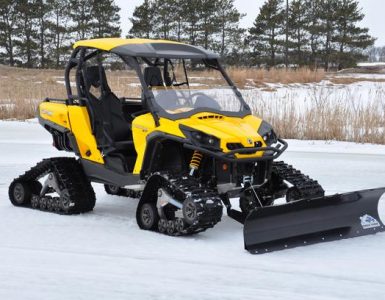Whether you’re a seasoned off-roading enthusiast or a casual ATV rider, an ATV winch is a must-have tool that can make a significant difference in your adventure. ATV winches are designed to help you get out of sticky situations, whether you’re stuck in mud, snow, or even have a heavy load to pull. However, with a wide variety of options on the market, choosing the right winch can be a bit overwhelming. This buyer’s guide will break down everything you need to know before purchasing an ATV winch, ensuring you make an informed decision and select the right winch for your needs.
What Is an ATV Winch?
An ATV winch is a mechanical device used to pull or lift heavy loads. It’s typically installed on the front or rear of your ATV, and it consists of a spool, rope or cable, motor, and a drum. When you’re stuck in a tough spot, the winch can pull your ATV out of mud, snow, or other obstacles, or even help you pull other vehicles or objects. Essentially, it’s like having a towing tool right on your vehicle, making it an indispensable piece of equipment for off-road enthusiasts.
Why Do You Need an ATV Winch?
Before we dive into the details of choosing the right winch, let’s first discuss why you need one. Here are some reasons to consider investing in an ATV winch:
- Self-Recovery: If you’re off-roading and get stuck, an ATV winch can pull your vehicle out, saving you the hassle of waiting for a tow truck or other help.
- Towing Power: Whether you’re hauling another ATV or moving heavy objects, a winch can help you get the job done without overexerting yourself.
- Emergency Use: In case of an emergency, an ATV winch can help you pull objects off the trail or even assist in clearing debris.
- Versatility: Winches are useful for many other tasks like dragging trees, clearing trails, or moving large objects, making them a versatile tool for various off-road activities.
Factors to Consider Before Buying an ATV Winch
Now that you know what an ATV winch is and why you might need one, let’s explore the factors you should consider before making your purchase. Choosing the right winch depends on various factors, including the type of ATV you have, how you plan to use it, and your budget. Let’s break it down.
1. Winch Capacity
The first thing you need to consider when purchasing an ATV winch is the winch capacity. This refers to the maximum weight the winch can pull. It’s essential to select a winch with enough capacity to handle your ATV’s weight, plus the weight of any other items you may need to tow or recover.
- Rule of Thumb: Choose a winch with a capacity that’s at least 1.5 times the weight of your ATV. For example, if your ATV weighs 600 pounds, go for a winch with a capacity of at least 900 pounds.
- Heavy-Duty Applications: If you plan on towing heavy objects, hauling other vehicles, or using the winch for more demanding tasks, opt for a winch with a higher weight capacity to handle those situations.
2. Winch Type: Electric vs. Hydraulic
There are two primary types of ATV winches: electric and hydraulic. Each has its advantages and limitations, and your choice depends on your needs.
Also Read:
Electric Winches
Electric winches are the most common and widely used type for ATVs. They run on the electrical system of your ATV, using a motor to operate the winch.
- Pros:
- Easy to install and use.
- Available in a range of sizes and capacities.
- Most affordable option.
- Easy to find parts and accessories.
- Cons:
- May not be as powerful as hydraulic winches.
- Can draw a lot of power from your ATV’s battery, potentially leaving you with a drained battery if used excessively.
Hydraulic Winches
Hydraulic winches use the power of your ATV’s hydraulic system to operate, making them more powerful than electric winches. However, they are less common for ATV use and tend to be found on heavier vehicles like trucks.
- Pros:
- Greater pulling power and performance.
- Can run continuously without overheating.
- Ideal for heavy-duty applications.
- Cons:
- More expensive than electric winches.
- Requires additional installation for hydraulic lines.
- Can be more complicated to maintain.
For most ATV owners, an electric winch is the better option, as it strikes a balance between performance and affordability. However, if you have a heavy-duty ATV or you plan on performing extremely demanding tasks, a hydraulic winch might be worth considering.
3. Rope or Cable: Synthetic vs. Steel
When it comes to the material used for the winch rope or cable, there are two main options: synthetic rope and steel cable. Both have their pros and cons, and the best choice depends on your personal preference and the type of terrain you plan to tackle.
Synthetic Rope
Synthetic rope is made from materials like nylon or polyethylene, and it is quickly becoming the preferred choice for most ATV winches.
- Pros:
- Lighter and easier to handle compared to steel cable.
- Safer to use because it doesn’t fray or snap as easily.
- Floats on water, making it ideal for wet conditions.
- Doesn’t rust or corrode.
- Cons:
- More expensive than steel cable.
- Less durable in harsh conditions, such as abrasive rock or rough terrain.
Steel Cable
Steel cable has been the traditional choice for winch lines, known for its durability and strength.
- Pros:
- Stronger and more durable in rough, rocky conditions.
- Can handle high temperatures and is resistant to UV damage.
- Cons:
- Heavier and more difficult to handle.
- Prone to rust and corrosion, especially if exposed to the elements.
- Can snap and cause injury if not handled properly.
If you’re looking for a lightweight, safe, and easy-to-handle winch line, synthetic rope is the way to go. However, if you’re tackling rugged terrain and need maximum durability, steel cable might be the better option for you.
4. Mounting Options
The next consideration is how you’ll mount your winch to your ATV. Most ATV winches are designed to be mounted either on the front or the rear of the vehicle, depending on your needs.
- Front Mount: Front-mounted winches are the most common, as they allow for easy recovery when you get stuck. They are mounted directly in front of your ATV and are ideal for pulling yourself out of challenging situations.
- Rear Mount: If you’re looking to tow or haul items, a rear-mounted winch might be the better option, as it provides more control when pulling from behind.
5. Speed and Power
Winch speed is important, especially when you’re stuck in a difficult situation and need to get out fast. Generally, the more powerful the motor, the faster the winch will operate. However, keep in mind that higher speed can result in less pulling power.
When selecting a winch, balance speed and power to ensure you can recover your vehicle quickly while still having the necessary strength to pull yourself out of tough situations.
6. Quality and Durability
You want a winch that’s built to last. A good quality ATV winch should be able to withstand harsh conditions, including dirt, mud, water, and extreme temperatures. Look for winches made by reputable brands that offer warranties and have a proven track record in off-roading gear.
7. Price
Price is always a factor when making a purchase, and ATV winches come in a wide range of price points. Typically, electric winches with synthetic rope are more affordable, while hydraulic winches and winches with steel cables tend to be more expensive.
However, keep in mind that while it might be tempting to buy the cheapest winch you find, investing in a higher-quality winch can save you headaches and money in the long run. A winch that fails during an emergency or doesn’t have enough pulling power could leave you stranded or cause further damage to your ATV.
Conclusion
Choosing the right ATV winch requires careful consideration of your specific needs and preferences. By focusing on factors such as winch capacity, type (electric vs. hydraulic), rope material, mounting options, speed, durability, and price, you can find the perfect winch to complement your ATV and improve your off-roading experience. Keep these tips in mind, and you’ll be well-equipped to make a smart purchase that ensures you’re prepared for any situation on the trail.





Add comment